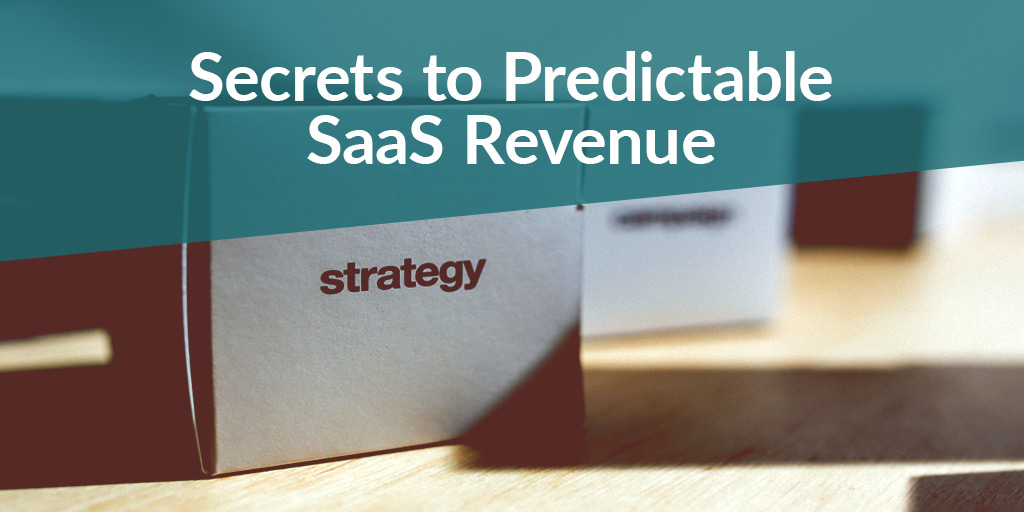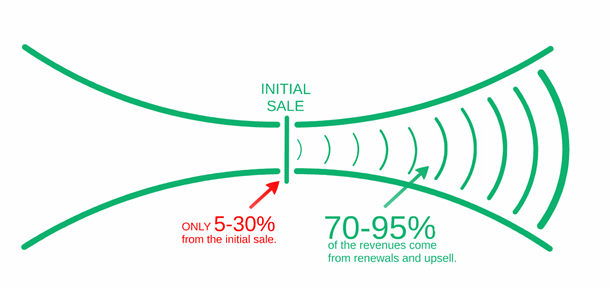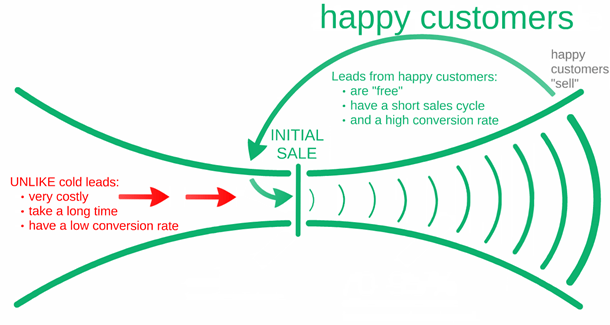Great article, Nils!!!
Secrets to Predictable SaaS Revenue

Growing a business is tough, especially when you can’t depend on its revenue.
If your model is based entirely on one-off sales, it will be hard to delegate funds. Will spending $10,000 on marketing this month affect payroll? Will growing your team force you to hustle to pay your overhead costs? These dilemmas force some businesses to delay growth in order to stockpile cash and protect themselves from dry spells.
Revenue predictability is a luxury for many businesses, but it’s quite possible for a subscription-based software service. In fact, predictability and growth go hand in hand.
Customers who don’t churn pay for next month’s services, and so on. The longer a customer pays for your services, the less likely they are to churn. Retention, therefore, is the answer to predictability.
“The fact that customer profitability tends to increase over the life of a retained customer is added incentive for businesses to allocate more resources to sharpening their customer retention strategies,” says customer feedback tool Client Heartbeat.
Look at it this way: 5% monthly churn doesn’t sound bad. 5% isn’t much, right? However, 5% over the year is 46%. How predictable would your revenue be if half of your customers left every year? It would make planning large-scale projects with long timelines impossible because you couldn’t depend on the money to pay for them.
So if retention creates predictable revenue, how do we retain customers?
Attracting and selling to the right customer
Retaining a customer hinges on providing value. You need to create enough value in their lives (in terms of more ROI or less stress) so they prefer to use your product/service rather than a competitor’s service or a homegrown solution.
There are a lot of ways to deliver value, but it’s a lot easier when your customer aligns with your software’s purpose. If you try to force a square peg into a round hole, you’ll burn through resources trying to satisfy a customer, but fail anyway.
Therefore, you can create predictable revenue by selling to the right person.
According to business management experts at MIT Sloan, “Many companies pursue growth opportunities without adequately defining who their ideal customers are. That lack of clarity can hamper profitable growth.”
That’s a lot harder than it sounds if there’s a disconnection between Sales and Customer Success. A sales team operating on their own little island will sell the product to anyone. As far as they’re concerned, any customer that fulfills their quota is a win.
But if Sales closes a customer who is a poor fit, that customer is likely to churn. Every resource spent selling and onboarding that customer will have been wasted. Your retention depends on aligning Sales and CS in a way that recognizes the entire lifecycle of a customer (who the customer is today and who they will be in five years, for instance).
Well-fit customers become happy customers, who eagerly refer you to their friends and partners, who turn into warm leads and eventually sales. It’s a simple, proven equation: happy customers bring more customers.

Source: foreentrepreneurs.com
The task of collecting data to refine the “ideal customer” falls on your CS team. Overtime, CS will learn which types of customers receive the most value from the product and which receive the least, with varying degrees in between. All of the intelligence they gather after the sale should be packaged for the sales team. They can provide sales with data to find well-fit customers and indicators to recognize poor-fit customers.
Most importantly, a process that focuses on the well-fit customer gets your sales team thinking about retention. In a SaaS business, everyone needs to worry about retaining customers.
Define your team’s roles properly
SaaS consultant Aaron Ross has written an interesting book called Predictable Revenue. In his book, he harps on the importance of segmenting sales and creating the Customer Success role that focuses on improving retention and upselling new services. He proposes four roles that work cooperatively to bring and keep customers.
- Outbound prospecting – Creating and qualifying sales opportunities and passing them to sales
- Inbound lead qualification – Qualifying leads that come in and passing them to sales
- Sales (or account executives) – Receiving leads and closing deals
- Customer Success – Helping existing customers achieve value with the product and renewing
(Ross lumps account management into the Customer Success role, but I disagree here. Account management is a relationships role, whereas Customer Success is a systems role.)
Role segmentation lets you build clarity and accountability into your business. By pairing metrics with each role, you can evaluate the effectiveness of that department.
For instance, if sales is tasked with retaining customers but they earn commissions from new sales, which are they likely to favor? Role segmentation makes it clear who is in charge of a particular metric.
It also improves your hiring because you can bring on specialists who focus on one sphere of influence. A salesmen is not built to serve customers.
Most importantly, role segmentation allows your business to scale faster. With the right process, team members can respond to problems and execute projects more quickly.
Driving growth with Customer Success
In any subscription-based model, increasing the growth rate is difficult. (I’m not saying growth is hard, but increasing the rate of growth can be.) In many cases, just maintaining the current growth level requires tremendous planning and resources. Over time, however, growth rate universally decays (a company can’t grow 50% every year indefinitely).
Sales are important, but they shouldn’t be your focus when you need your current customers to pay you next month and every month thereafter. Sales only begin the relationship. Customer Success maintains the relationship for the long haul.
In fact, over time a majority of your revenue will come from renewals and upsells. Preserving your customer base is paramount. If it’s done properly, you can attribute a majority of your income to Customer Success.

Source: foreentrepreneurs.com
Companies that focus on selling to new clients rather than engagement and renewals fail to scale. You can’t build upwards if your foundation is crumbling. Customer Success focuses on customer training, onboarding, client analysis and customer experience optimization – all areas that keep customers onboard.
I recommend that a Customer Success Manager be one of the first 10 (maybe 15) hires in a startup. Smart, well-funded companies in Silicon Valley are heavily investing in Customer Success early. By the time they reach $5 to $6 million in revenue, it’s not unusual to have two or four CSMs.
Fortunately, measuring the value of Customer Success is conceptually simple. Measure churn rates (or, conversely, retention rates) and upsell revenue against periods before and after your CSM hire.
Final thoughts
I know every new business has a sell-sell-sell mentality. It’s hard to overcome, especially for early businesses who are staring success in the face. Remember: a SaaS with predictable profitability means focusing on retaining your customer base.
